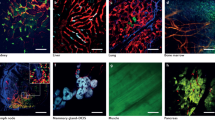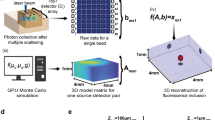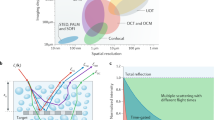Abstract
Intravital multiphoton microscopy has provided powerful mechanistic insights into health and disease and has become a common instrument in the modern biological laboratory. The requisite high numerical aperture and exogenous contrast agents that enable multiphoton microscopy, however, limit the ability to investigate substantial tissue volumes or to probe dynamic changes repeatedly over prolonged periods. Here we introduce optical frequency domain imaging (OFDI) as an intravital microscopy that circumvents the technical limitations of multiphoton microscopy and, as a result, provides unprecedented access to previously unexplored, crucial aspects of tissue biology. Using unique OFDI-based approaches and entirely intrinsic mechanisms of contrast, we present rapid and repeated measurements of tumor angiogenesis, lymphangiogenesis, tissue viability and both vascular and cellular responses to therapy, thereby demonstrating the potential of OFDI to facilitate the exploration of physiological and pathological processes and the evaluation of treatment strategies.
This is a preview of subscription content, access via your institution
Access options
Subscribe to this journal
Receive 12 print issues and online access
$209.00 per year
only $17.42 per issue
Buy this article
- Purchase on Springer Link
- Instant access to full article PDF
Prices may be subject to local taxes which are calculated during checkout





Similar content being viewed by others
References
Masters, B.R. & So, P.T. Handbook of Biomedical Nonlinear Optical Microscopy 735–756 (Oxford University Press, New York, 2008).
Brown, E.B. et al. In vivo measurement of gene expression, angiogenesis and physiological function in tumors using multiphoton laser scanning microscopy. Nat. Med. 7, 864–868 (2001).
Jain, R.K. Normalization of tumor vasculature: An emerging concept in antiangiogenic therapy. Science 307, 58–62 (2005).
Huang, D. et al. Optical coherence tomography. Science 254, 1178 (1991).
Yun, S.H., Tearney, G.J., de Boer, J.F., Iftimia, N. & Bouma, B.E. High-speed optical frequency-domain imaging. Opt. Express 11, 2953–2963 (2003).
Carmeliet, P. Angiogenesis in life, disease and medicine. Nature 438, 932–936 (2005).
Izatt, J.A., Kulkami, M.D., Yazdanfar, S., Barton, J.K. & Welch, A.J. In vivo bidirectional color Doppler flow imaging of picoliter blood volumes using optical coherence tomograghy. Opt. Lett. 22, 1439–1441 (1997).
Chen, Z., Milner, T.E., Dave, D. & Nelson, J.S. Optical Doppler tomographic imaging of fluid flow velocity in highly scattering media. Opt. Lett. 22, 64–66 (1997).
Zhao, Y. et al. Phase-resolved optical coherence tomography and optical Doppler tomography for imaging blood flow in human skin with fast scanning speed and high velocity sensitivity. Opt. Lett. 25, 114–116 (2000).
Vakoc, B.J., Yun, S.H., de Boer, J.F., Tearney, G.J. & Bouma, B.E. Phase-resolved optical frequency domain imaging. Opt. Express 13, 5483–5493 (2005).
Collins, H.A. et al. Blood-vessel closure using photosensitizers engineered for two-photon excitation. Nat. Photonics 2, 420–424 (2008).
Wang, R.K.K. & Hurst, S. Mapping of cerebro-vascular blood perfusion in mice with skin and skull intact by optical micro-angiography at 1.3 mu m wavelength. Opt. Express 15, 11402–11412 (2007).
Yun, S.H. et al. Comprehensive volumetric optical microscopy in vivo. Nat. Med. 12, 1429–1433 (2006).
Baish, J.W. & Jain, R.K. Fractals and cancer. Cancer Res. 60, 3683–3688 (2000).
Jain, R.K. Molecular regulation of vessel maturation. Nat. Med. 9, 685–693 (2003).
Tyrrell, J.A. et al. Robust 3-D modeling of vasculature imagery using superellipsoids. IEEE Trans. Med. Imaging 26, 223–237 (2007).
Gazit, Y. et al. Fractal characteristics of tumor vascular architecture during tumor growth and regression. Microcirculation 4, 395–402 (1997).
Gazit, Y., Berk, D.A., Leunig, M., Baxter, L.T. & Jain, R.K. Scale-invariant behavior and vascular network formation in normal and tumor tissue. Phys. Rev. Lett. 75, 2428–2431 (1995).
Isaka, N., Padera, T.P., Hagendoorn, J., Fukumura, D. & Jain, R.K. Peritumor lymphatics induced by vascular endothelial growth factor-C exhibit abnormal function. Cancer Res. 64, 4400–4404 (2004).
Padera, T.P. et al. Lymphatic metastasis in the absence of functional intratumor lymphatics. Science 296, 1883–1886 (2002).
Sharma, M., Verma, Y., Rao, K.D., Nair, R. & Gupta, P.K. Imaging growth dynamics of tumour spheroids using optical coherence tomography. Biotechnol. Lett. 29, 273–278 (2007).
Tong, R.T. et al. Vascular normalization by vascular endothelial growth factor receptor 2 blockade induces a pressure gradient across the vasculature and improves drug penetration in tumors. Cancer Res. 64, 3731–3736 (2004).
Arbiser, J.L. et al. Isolation of mouse stromal cells associated with a human tumor using differential diphtheria toxin sensitivity. Am. J. Pathol. 155, 723–729 (1999).
Padera, T.P. et al. Cancer cells compress intratumour vessels. Nature 427, 695 (2004).
Padera, T.P. et al. Differential response of primary tumor versus lymphatic metastasis to VEGFR-2 and VEGFR-3 kinase inhibitors cediranib and vandetanib. Mol. Cancer Ther. 7, 2272–2279 (2008).
Jain, R.K., Brown, E.B., Munn, L.L. & Fukumura, D. Intravital microscopy of normal and diseased tissues in the mouse. in Live Cell Imaging: a Laboratory Manual (eds. Goldman, R.D. & Spector, D.L.) 435–466 (Cold Spring Harbor Laboratory Press, Cold Spring Harbor, New York, 2005).
Leunig, M. et al. Angiogenesis, microvascular architecture, microhemodynamics and interstitial fluid pressure during early growth of human adenocarcinoma LS174T in SCID mice. Cancer Res. 52, 6553–6560 (1992).
Yuan, F. et al. Vascular permeability and microcirculation of gliomas and mammary carcinomas transplanted in rat and mouse cranial windows. Cancer Res. 54, 4564–4568 (1994).
Acknowledgements
We thank J. Baish for insightful input regarding fractal analysis. We also thank J. Kahn and S. Roberge for preparation of animal models, P. Huang for animal care and colony maintenance, and E. di Tomaso and C. Smith for histological preparations. We thank Genentech for supplying the MDA-MB-361HK mammary carcinoma cells and J.B. Little of the Harvard School for Public Health for HSTS26T. This research was funded in part by US National Institutes of Health grants P01-CA080124, R01-CA085140, R01-CA115767, R01 CA126642, R33-CA125560, K25-CA127465, K99-CA137167, and R01-CA096915. R.M.L. is supported in part by US Department of Defense Breast Cancer Research Program fellowship W81XWH-06-1-0436.
Author information
Authors and Affiliations
Contributions
B.J.V. developed OFDI technology. B.J.V. and R.M.L. designed and performed most of the experiments, developed methodology, headed all data analysis and wrote the manuscript. J.A.T. contributed to vascular tracing of OFDI data. T.P.P. performed lymphangiography experiments and contributed to data analysis and manuscript preparation. L.A.B. performed VEGFR-2 blockade in vivo experiments. T.S. developed and performed fractal characterization and contributed to manuscript preparation. L.L.M. contributed to vascular data analysis. G.J.T. contributed to OFDI technology development. D.F. contributed to experimental design and manuscript preparation. R.K.J. and B.E.B. contributed to the design of experiments, preparation of the manuscript and supervised the project.
Corresponding authors
Ethics declarations
Competing interests
R.K.J. is a consultant for AstraZeneca, Dyax and Millenium and has received research grants from AstraZeneca and Dyax. He has received honoraria for lectures from Roche and Pfizer. He is on the scientific advisory boards for Enlight and SynDevRx. B.J.V., G.J.T. and B.E.B. are inventors of the optical frequency domain imaging apparatus and methods used in the research described by this manuscript.
Supplementary information
Supplementary Text and Figures
Supplementary Figures 1–10 and Supplementary Methods (PDF 6251 kb)
Supplementary Video 1
Time-lapse video of an MCaIV tumor implanted in the dorsal skinfold chamber. Changes in tumor microvasculature are shown starting 8 h before to 40 h after DC101 treatment. Tumor volume and mean intratumoral vessel diameter are tracked at 2 h intervals for 48 h. (MOV 2611 kb)
Rights and permissions
About this article
Cite this article
Vakoc, B., Lanning, R., Tyrrell, J. et al. Three-dimensional microscopy of the tumor microenvironment in vivo using optical frequency domain imaging. Nat Med 15, 1219–1223 (2009). https://doi.org/10.1038/nm.1971
Received:
Accepted:
Published:
Issue Date:
DOI: https://doi.org/10.1038/nm.1971
This article is cited by
-
Astrocytes modulate cerebral blood flow and neuronal response to cocaine in prefrontal cortex
Molecular Psychiatry (2024)
-
Experimental and theoretical model of microvascular network remodeling and blood flow redistribution following minimally invasive microvessel laser ablation
Scientific Reports (2024)
-
Deep learning-based label-free imaging of lymphatics and aqueous veins in the eye using optical coherence tomography
Scientific Reports (2024)
-
Emerging hallmark of gliomas microenvironment in evading immunity: a basic concept
The Egyptian Journal of Neurology, Psychiatry and Neurosurgery (2023)
-
Evaluation of growth-induced, mechanical stress in solid tumors and spatial association with extracellular matrix content
Biomechanics and Modeling in Mechanobiology (2023)



